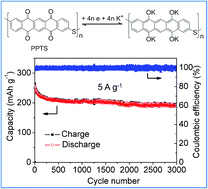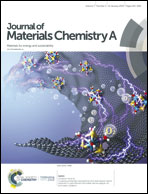An organic cathode with high capacities for fast-charge potassium-ion batteries†
Abstract
Potassium-ion batteries (PIBs) are promising candidates for future large-scale energy storage due to the high abundance of potassium and comparable electrode potential to that of lithium. However, most of the reported cathodes of PIBs still suffer from limited capacity, low cyclability and poor rate performance probably due to the bulky size of K-ions. In this work, we report the application of poly(pentacenetetrone sulfide) (PPTS) as a cathode for PIBs. The PPTS cathode exhibited high reversible capacity (∼260 mAh g−1 at 0.1 A g−1), fast-discharge/charge ability (∼160 mAh g−1 at a current density of 10 A g−1) and long cycle life (capacity higher than 190 mAh g−1 even after 3000 cycles at 5 A g−1). To the best of our knowledge, these performances are among the best results of all the reported inorganic/organic materials for potassium-ion batteries. We also systematically studied methods for inhibiting potassium dendrites. This work will stimulate growing interest in organic cathodes for PIBs, provide practical pathways toward safe K metal anodes and pave the way to achieve PIBs for large-scale applications.



 Please wait while we load your content...
Please wait while we load your content...